Guide H-505
Bernd Leinauer
College of Agricultural, Consumer and Environmental Sciences, New Mexico State University
Author: Extension Turfgrass Specialist, Department of Extension Plant Sciences, New Mexico State University. (Print friendly PDF)
Mowing is one of the most basic turfgrass cultural practices, along with irrigation and fertilization, and is important for maintaining an attractive lawn. Mowing involves the periodic removal of a portion of the turfgrass's aboveground plant material (leaves and stems). Turfgrasses can survive this rather rigorous and continuous defoliation because they have evolved adaptation mechanisms under the selection pressure of grazing animals.
Mowing affects turf density, weed infestation, water consumption, and susceptibility to environmental stresses. Mowing can improve the appearance of the lawn or provide a uniform playing surface for certain sports. In order to maintain an attractive and healthy turf, the correct mowing height and mowing frequency must be followed.
The following important mowing aspects are addressed in this guide and should be considered.
- Mowing height
- Mowing frequency
- Returning or removing clippings
- Mower selection
- Mowing pattern
- Special care to trees
Mowing Height
Proper mowing height depends on the grass species, its growth habit, time of year, intended use of the area, and the user's quality expectations. Table 1 gives the preferred mowing height of commonly used cool and warm season turfgrass species in New Mexico.
| Table 1. Mowing Heights for Warm and Cool Season Turfgrass Species in Different Turf Areas | ||||
|---|---|---|---|---|
| Mowing height (inches) | ||||
| Grass type | Grass species | Residential lawns | General grounds and parks | Athletic fields |
| Cool season | Fine fescues | 0.5-1.5 | 0.5-1.5 | N.R.* |
| Kentucky bluegrass | 1-3 | 2-3 | 0.75-2 | |
| Perennial ryegrass | 1-3 | 2-3 | 0.75-2 | |
| Tall fescue | 2-3.5 | 2.5-3.5 | 2-3 | |
| Warm season | Bermudagrass | 0.5-1.5 | 1-3 | 0.5-2 |
| Buffalograss | 1.5-4 | 2.5-4 | N.R. | |
| Seashore paspalum | 0.5-1.5 | 1.5-3 | 0.5-1.5 | |
| St. Augustinegrass | 1-3 | 2-3 | N.R. | |
| Zoysiagrass | 0.5-2 | 1.5-3 | 0.5-1.5 | |
| *N.R. Not recommended | ||||
The effects of closer mowing include increased shoot density but decreased root growth. Closer mowing produces a denser turf that has more plants per surface area; dense turf is considered to be of greater quality because the canopy is more uniform and aesthetically more pleasing. However, closer mowing produces a turf that is less tolerant of environmental stresses and more prone to diseases. The shallower root system requires more frequent irrigation and fertilization to compensate for the turf's reduced ability to secure moisture and nutrients from the soil. A common practice is to raise the mowing height during periods of increased environmental stresses, such as heat and drought stress in the summer and cold temperature stress in the winter.
Keep the blade sharp
The key to a quality mowing job is a sharp blade. Dull blades beat and tear the grass, leaving frayed edges that give a whitish cast to the lawn. Sharp blades improve the energy efficiency of mowing by cutting cleaner and quicker with less power. Inspect the blade after each mowing for nicks and dullness. The amount of mowing, grass species, and debris struck determine how often the blade must be sharpened. Blades should be sharpened at least once a year in the spring when the mowing season starts. Correct sharpening requires several tools, such as wrenches, a vise, a power grinder, and a balance tester. Since most households do not have these tools readily available, it is recommended that the sharpening be done by a professional.
Mowing Frequency
Turfgrass areas should be mowed frequently enough so you never remove more than 30% of the aboveground tissue (called the one-third rule). Consequently, the mowing frequency is determined by the desired turfgrass height and the growth rate of the turf. For example, if the desired height of a turfgrass area is 1 in., it should be mowed when a height of 1.5 in. is reached; if the desired height is 2 in., it should be mowed at 3 in. (Table 2). If the desired turf height is less than 1 in., mowing may be necessary more than once a week.
| Table 2. When to Mow: The Desired Turf Height Determines the Height When Mowing Is Required | ||
|---|---|---|
| Desired turf height (inches) |
Height when turf requires mowing (following one-third rule) (inches) |
Height of grass removed (one-third) (inches) |
| 1.0 | 1.50 | 0.50 |
| 1.5 | 2.25 | 0.75 |
| 2.0 | 3.00 | 1.00 |
| 2.5 | 3.75 | 1.25 |
| 3.0 | 4.50 | 1.50 |
| 3.5 | 5.25 | 1.75 |
| 4.0 | 6.00 | 2.00 |
Cool season grasses grow fastest during spring and fall, but grow slowly (if at all) during summer and winter. Warm season grasses grow best and fastest during the summer. Therefore, it is important to mow according to the growth rate of the turf and not with the same frequency all year long.
Scalping
Removing more than 40% of the turf's height in a single mowing can cause scalping. Scalping results in tan to brown colored patches and can expose the lower part of the plants, such as stolons and crowns or even bare soil. Scalping during periods of stress can damage or kill the turf. Since it takes time for the turf to recover from scalping, weeds can germinate and encroach during the recovery period and cause unsightly areas in the lawn. Figure 1 shows scalping damage on a golf course and on a residential lawn.

Figure 1. Scalping damage on a golf course (left) and residential lawn (right).
However, scalping can be helpful in turfgrass recovering from dormancy. Particularly on warm season zoysiagrass and bermudagrass, removing 50 to 75% of the dead tissue by mowing at a very low setting or using a verticutter will aid in a fast spring green-up of the turf. In this case, scalping will open the canopy and allow sunlight to reach the soil surface, which increases the temperature in the top root zone and in the open canopy. This promotes new growth from the crown faster than if old, dead tissue was not removed (Figure 2).
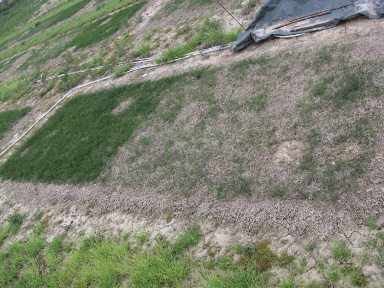
Figure 2. Bermudagrass that is scalped in early spring greens up faster (left side of picture) than grass that was left unscalped (right side) (Photo courtesy of Filippo Rimi).
Returning or Removing Clippings
If the proper mowing frequency is followed and the turf is mowed often enough, clippings can be left on lawns. They will filter into the canopy, decompose quickly, and return valuable nutrients to the grass plants. However, if tall grass is mowed in one pass and produces a large amount of clippings that remain on top of the grass, they should be removed (Figure 3).
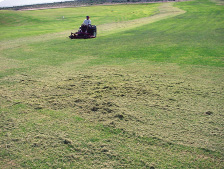
Figure 3. Excessive amounts of clippings after mowing should be removed.
Recent advances in rotary mower technology lead to the development of mulching mowers. Modifications of rotary mowers include specially designed mulching blades and/or restrictions on the grass discharge ports. These modifications produce very small clippings that can be easily decomposed within the turf canopy and on the soil surface. Such clippings do not have to be collected and sent to a landfill.
When turf is mowed frequently, clippings contain 90% water and therefore do not contribute to thatch
accumulation. Clippings also consist of approximately 4% nitrogen, 0.5 to 1% phosphorous, and approximately 2% potassium, as well as essential micronutrients. Grass clippings returned to the lawn can reduce fertilizer use by 25%.
Mower Selection
Three types of mowers are commonly used for mowing turfgrass: flail, reel, and rotary. The mower should be adjustable for the range recommended for the predominant grass species and should match the quality expectations for the lawn.
Flail mower
The mowing component in a flail mower consists of numerous small knives hinged to a horizontal shaft. The shaft rotates and the knives cut any kind of vegetation and debris to a finely ground mulch. Mowing quality of flail mowers is rather low, and the mowing action can be compared to the chopping of an axe. They are used on infrequently mowed turfs where appearance does not play a major role (e.g., roadsides) (Figure 4).
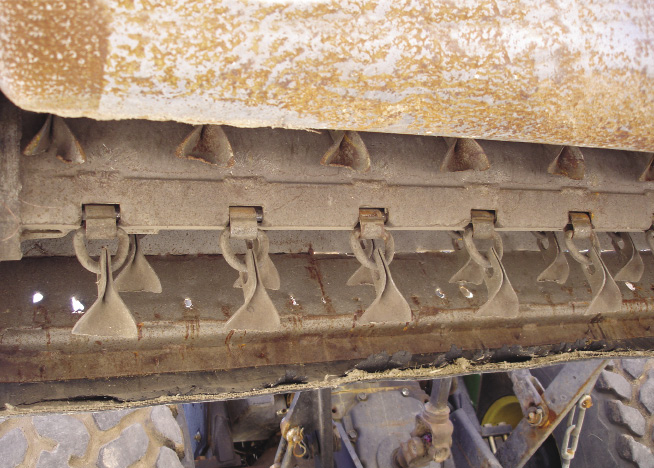
Figure 4. Flail mower.
Reel mower
Reel mowers use a shearing action (much like scissors) to cut grass by catching grass blades between the rotating reel and the bedknife (Figure 5). They provide the highest quality cut of all three types of mowers and are best suited for low cut areas on golf courses (greens and tees); on high-quality, low cut athletic fields; and on home lawns that require a height of 1 in. or less. Reel mowers run quietly and usually do not scalp on uneven ground. Reel mowers present some disadvantages because they cannot be used for high grass and they require special care when sharpening the blades.
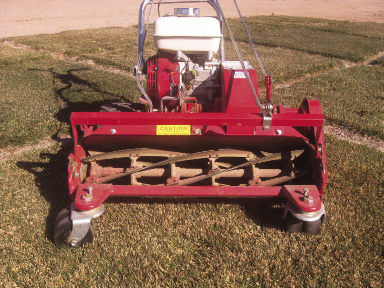
Figure 5. Reel mower.
Rotary mower
Rotary mowers are the primary type of mower used on most home lawns. They cut using the same principle as a scythe with a horizontally rotating blade cutting the grass. Rotary mowers range in size from small push behind units (Figure 6) to large riding units (Figure 7) that mow large areas in a short period of time. Rotary mowers are preferred for mowing heights greater than 1 in. and are easier to sharpen and maintain than reel mowers. However, they can be dangerous (throw objects), noisy, and may scalp uneven turf.
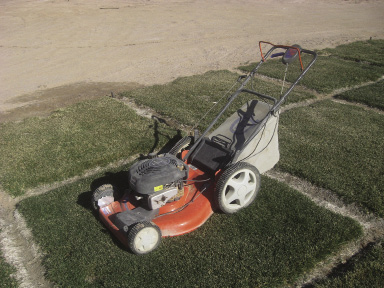
Figure 6. Push behind rotary mower.
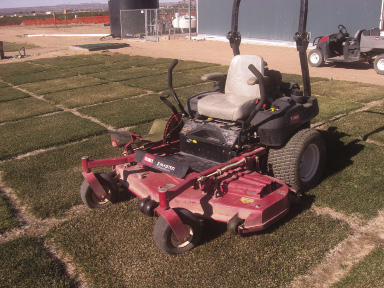
Figure 7. Riding rotary mower.
Mowing Pattern
Establishing a certain mowing pattern is necessary because grass blades tend to lean in the direction of mowing. The pattern should include mowing from different angles each time the grass is cut because leaves and stems that lean one direction will be cut when the mower comes from the opposite direction. Apply patterns with only a few turns as this will reduce soil compaction and will limit turf wear from turning the wheels.
When mowing without a catcher, make a few rounds throwing grass away from buildings, sidewalks, and driveways. After these rounds, change mowing direction and throw the clippings away from uncut grass. Repeatedly throwing clippings onto uncut grass makes the mower work harder, wastes energy, and results in a poor cutting job.
Special Care to Trees
Bumping young and thin-barked trees with a lawnmower or hitting them with a string trimmer causes serious injury and reduces growth and vigor of the tree. What seems like a minor bruise later enlarges into a deep wound that destroys the growth tissue just under the bark. Repeated bumping can result in the eventual death of the tree. To avoid bumping, apply hand trimming or maintain a cultivated or mulched area 1 to 1.5 feet wide around tree trunks.
References
Christians, N. 2003. Fundamentals of turfgrass management, 2nd edition. Hoboken, NJ: John Wiley & Sons, Inc.
Fagerness, M.J. 2001. Mowing your lawn (MF-1155). Manhattan, KS: Kansas State University Cooperative Extension Service.
Original author: Lynn Ellen Doxon, former Extension Horticulture Specialist.
For Further Reading
H-511: Turfgrasses for Northern New Mexico
H-504: How to Water Your Lawn
H-509: Turfgrass Establishment
H-510: How to Perform a Catch Can Irrigation Audit on a Home Lawn Sprinkler System

Bernd Leinauer is a professor and Extension Turfgrass Specialist in the Department of Extension Plant Sciences. He received his M.S. and Ph.D. degrees in crop and soil science from Hohenheim University in Stuttgart, Germany. His Extension and research program focuses on developing water management strategies for turf areas to reduce the amount of water used for irrigation.
To find more resources for your business, home, or family, visit the College of Agricultural, Consumer and Environmental Sciences on the World Wide Web at pubs.nmsu.edu
Contents of publications may be freely reproduced for educational purposes. All other rights reserved. For permission to use publications for other purposes, contact pubs@nmsu.edu or the authors listed on the publication.
New Mexico State University is an equal opportunity/affirmative action employer and educator. NMSU and the U.S. Department of Agriculture cooperating.
Reprinted March 2016.


